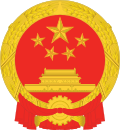| Level | Rank | Level name | Party positions | Government positions |
|---|
| 1 | 1 to 3 | National-level
(国家级正职) | | |
| 2 | 4 to 6 | Deputy national -level
(国家级副职) | | |
| 3 | 7 to 8 | Provincial and ministerial level
(省部级正职) | | - Provincial Governor (Mayor of a direct-controlled Municipality, Chairman of an Autonomous Region)
- Ministers of the State Council
- Commissioners or Directors of agencies that directly report to the State Council, such as the National Development and Reform Commission
- Chair of a Provincial-level People's Congress
- Chair of a Provincial-level People's Political Consultative Conference
- General Managers of key state-owned enterprises deemed to be "ministerial-level"
- Chair of national civic organizations such as the All-China Federation of Trade Unions, All-China Women's Federation, etc.
|
| 4 | 9 to 10 | Deputy-Provincial (Deputy-Ministerial) level
(省部级副职) | - Deputy Secretary of Party Committees of Provinces, Autonomous Regions, Direct-controlled Municipalities
- Standing Committee Members of provincial-level Party Committees
- Secretary of Party Committees of Sub-provincial cities
- Deputy leaders of bodies reporting directly to the Central Committee, such as the General Office, International Liaison, United Front, Organization, Propaganda, Politics-Law, Central Party School
- The chairman, secretary of the party committee (party group) and general manager of central enterprises such as State Grid Corporation of China
- Party Secretary of key universities, such as Peking University
| - Deputy Governor (Autonomous Region Chairman, Mayor)
- Deputy Ministers of the State Council
- Deputy Commissioners or Directors of agencies that directly report to the State Council
- Vice Chair of a Provincial-level People's Congress
- Vice Chair of a Provincial-level People's Political Consultative Conference
- President of key universities, such as Tsinghua University
|
| 5 | 11 to 12 | Bureau-Director level
(厅局级正职) | - Party Secretary of Prefecture-level cities and divisions
- Deputy Party Secretary of Sub-provincial cities
- Standing Committee members of Sub-provincial cities
- Heads of provincial party organizations (Organization, Propaganda, United Front, etc.)
- Party Secretary of provincially run universities, such as Hubei University
| - Mayor of Prefecture-level cities
- Vice Mayor of Sub-provincial cities
- Directors (ministers) of provincial departments
- Chairs of provincial civil organizations (Unions, Women's Federation etc.)
- Directors of departments of national-level ministries
- Chair of Prefecture-level People's Congress
- Chair of Prefecture-level People's Political Consultative Conference
- President of provincially run universities, such as Shanxi University
|
| 6 | 13 to 14 | Deputy-Bureau-Director level
(厅局级副职) | | - Vice Mayor of Prefecture-level cities
- Vice Chair of Prefecture-level People's Congress
- Vice Chair of Prefecture-level People's Political Consultative Conference
- Deputy Chairs of provincial civil organizations (Unions, Women's Federation etc.)
- Deputy directors (ministers) of provincial departments
|
| 7 | 15 to 16 | Division-Head level
(县处级正职) | - Party Secretary of Counties or County-level cities
- Party Secretary of Districts of Prefecture-level cities
- Heads of prefecture-level party organizations (Organization, Propaganda, United Front, etc.)
| - County Governors
- Governor of Districts of Prefecture-level cities
- Mayor of County-level cities
- Chair of County-level People's Congress
- Chair of County-level People's Political Consultative Conference
- Heads of sub-divisions of a provincial department
|
| 8 | 17 to 18 | Deputy-Division-Head level
(县处级副职) | - Deputy Party Secretary of Counties or County-level cities
- Deputy Party Secretary of Districts of Prefecture-level cities
- Standing Committee members of County-level Party Committees
| - Deputy County Governors
- Vice Mayor of County-level cities
- Vice Chair of County-level People's Congress
- Vice Chair of County-level People's Political Consultative Conference
|
| 9 | 19 to 20 | Section-Head level
(乡科级正职) | - Party Secretary of Towns or Townships
- Heads of county-level party organizations (Organization, Propaganda, United Front, etc.)
| - Magistrate of Townships (Mayor of Towns)
- Chair of Township-level People's Congress
- Chair of Township-level People's Political Consultative Conference
- Heads of sub-divisions of a prefecture-level department
|
| 10 | 21 to 22 | Deputy-Section-Head level
(乡科级副职) | - Deputy Party Secretary or Standing Committee member of Towns or Townships
- Deputy heads of county-level party organizations (Organization, Propaganda, United Front, etc.)
| - Deputy Magistrate of Towns or Townships
- Vice Chair of Township-level People's Congress
- Vice Chair of Township-level People's Political Consultative Conference
|
| 11 | 23 to 24 | Section member
(科员) | - Staff subordinate to a section-head
- Heads party organizations of township-level divisions
| - Staff subordinate to a section-head
- Head of local departments of towns and townships, such as a town police chief of financial secretary
|
| N/A | 25 to 27 | Ordinary Staff | - Any unranked person
- Village Party Branch Secretary
| - Any unranked person
- Village chief
|
